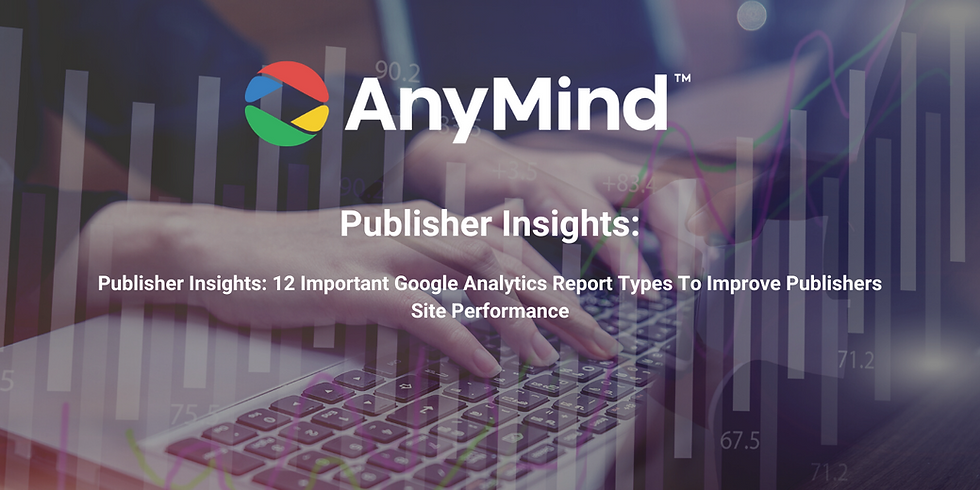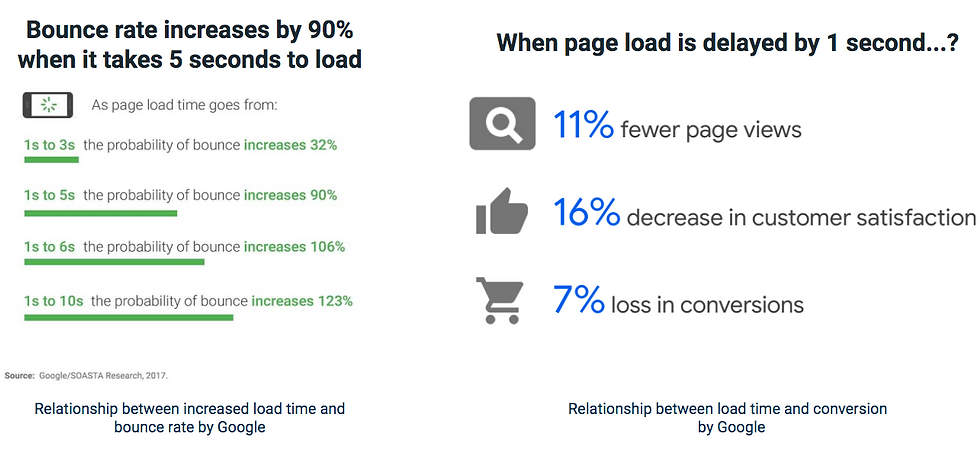12 Important Google Analytics Report Types To Improve Publishers Site Performance
- Ben Chien
- Nov 27, 2021
- 6 min read

Analyzing the website can help publishers to understand their target audience and behavior, so that the website can be optimized with the customer journey to suit the special interests and needs of users. Optimizing user journey can drive conversion increment, as users are more likely to buy a product/service when their experience with the brand that is highly relevant and personal. To analyze their site in deep, publishers can generate the report using the Google Analytics tool. Google analytics is an open source platform that can collect data on how users interact with websites (Moz #).
To input any data into the Google Analytics platform, publishers must place a tag on the website first. Attached below the screenshot on how to install the Google Analytics tag in the head code position. Once the tag is placed, Google Analytics will start reviewing the website and collecting data. The data is then entered into a report consisting of a matrix and dimensions. Metrics are the components that generate numbers on the platform. For example, the number of users, the number of purchases (conversion rate), the average time users visit the site (average time on site). On the other hand, dimensions are how the matrix can be segmented. For example, the average time users visit the site (average time on site) by landing page or conversion rates by device type.

By comparing matrices in the data, publishers can gather further insights and identify the reasons and correlations for user behavior on websites. In the discussion of this newsletter, 12 types of reports will be explained and described which can be analyzed as audience insights on the publisher’s site.
1. Landing Page Report

If the publisher has linked the Google Analytics property to Google Search Console, the publisher will have two landing page reports. The landing page report in Search Console is located under the acquisitions tab of the Google Analytics dashboard. However, this report is only limited to landing page data from search results. Site content on landing page reports: landing page reports on the behavior tab display page data from all traffic sources.
In Google Analytics, a landing page is the first page viewed in a session. So, in a Google Analytics report, the landing page is the entry point when users enter the publisher’s website. By studying the landing page report, publishers can see how the page can generate traffic, how visitors interact with the website (engaged time). In addition, this report also shows the media mix profile, conversion rates and can be used to increase the base price of the most in-demand inventory in order to better categorize it. To analyze landing page reports, publishers can go to Behaviour > Site Contents > Landing Page.
2. In Market Segments

By analyzing in market segments report, publishers can reach potential users who are actively searching or willing to purchase products or services. This can help publishers to target potential users to users who are more likely to convert. In this case, publishers can match relevant ads to display directly with their interests. For example, publishers can find out what type of product or service from direct advertising & PMP (Private Market Place) deals suits their target audience.
To analyze the in market segments report, publishers can go to Audience > Interests > Market Segments.
3. Affinity Categories

Affinity targeting shows users who have the longest interest in publisher sites in general. This report analyzes in a long period of time the type of audience that has interests and lifestyles as a whole. Thus, publishers can better understand the user’s identity to determine relevant website content which is always accessible by users at any time (evergreen content).
To understand more, the publisher’s affinity categories report can go to Audience > Interests > Affinity Categories.
4. Sessions per Pageviews

In engagement reports, session duration metrics and page depth sections, located in the report header are very useful because these reports show the interactions and interests that users have on the website. With this report, publishers can find out whether the site is usually accessed repeatedly by users (continuous engagement). On the other hand, publishers can also activate the auto-refresh function on ads on pages with high session duration to increase ad revenue performance (usually above 30 seconds).
To learn more about these two matrices, publishers can go to Audience > Behaviour > Engagement (Session Durations and Page Depth).
5. Source/Medium

This report shows the type of category users come from and the actual domain that sent users to the publisher’s site, so that publishers can better see which domains or categories they should really focus on. For example, most of the traffic comes from one of the social media medium sources with a percentage of 50% of all traffic sources, hence publishers can consider to improve this strategy. On the other hand, publishers can improve the user experience as well for the lowest-rated medium.
To better analyse the source/medium report, publisher can go to Acquisition > All Traffic > Source/Medium.
6. Benchmarking

Benchmarking reports allow publishers to look at trends happening in the industry as a whole to gain insights into how well the site is performing compared to competitors. Publishers can see green and red flags indicating positive and negative signs of the publisher’s site performance metrics compared to current market performance metrics. By using this report, publishers can prioritize opportunities to increase investment in time and resource allocation, set realistic goals, maintain competitive advantage, and market benchmarking.
To understand more about benchmarking reports, publishers can go to Audience > Benchmarking > Channel.
7. Exit Pages

By analyzing this last page in each user session, publishers can make decisions to set up call to action or pop-up alerts to users before they leave the site, for example subscribing to newsletters, emails or following publishers social media pages. If the total page exit exceeds 50% it can be indicated as an issue.
To analyse exit pages report better publishers can go to Behavior > Site Content > Exit Pages.
8. Site Speed Suggestions

The site speed suggestions report shows how quickly users are viewing and interacting with content so publishers can identify areas that need improvement, and then track the extent of those improvements. This report is also directly correlated with user experience and search rankings. In addition, this report also provides a detailed list of data from average page load time and page speed score along with practical guidelines. Publishers can do several things above to increase page speed and ad-delivery speed.
To learn more about the site speed suggestions report, publishers can go to Behaviour > Site Speed > Speed Suggestions.
9. Search Terms Report

This report shows the actual queries that users have searched and the number of unique searches for each query. Interestingly, in this report publishers can see if people are looking for something that publishers currently do not have in their website content. In this case, publishers can identify gaps in content that can be filled, making it easier for users to find the content they are really looking for. If there are several existing queries mentioned in the website content, the publisher can re-elaborate on these specific terms to inform the publisher’s product services in more detail.
To analyse search terms report better publishers can go to Behavior > Site Search > Search Terms.
10. Geo Report

Geo report in Google Analytics tells publishers where the users who visit the website are coming from. The geographic location of visitors can be analyzed at various levels, such as country, region, and city. Using this report, publishers can optimize the user experience by providing them with localized content. In addition, publishers can also use geo reports to segment by location, check if there are referral spammers and internal visitors.
To analyze the publisher’s geo report, go to Audience > Geo > Location.
11. Top Events Report

The interactions/activities of users with elements of a publisher’s web page can be called ‘events’. Events on the website can be in the form of downloading files, playing videos, scrolling the web, clicking buttons, and others. Analyzing top events help publishers learn what events users are most interested in, resulting in more pageviews on web pages.
To learn more about the top events report, publishers can go to Behaviour > Events > Top Events.
12. Goal Report

Having goals configured correctly allows Analytics to provide publishers with important information, such as conversion counts and conversion rates for the publisher’s site. Without this information, it is difficult to evaluate the effectiveness of the publisher’s online business and marketing campaigns. In addition, setup goals also help publishers to understand how much resources should be invested, as well as what changes are needed to improve site performance.
To analyze the publisher’s goal report, go to Conversions > Goals > Overview.
13. Solution by AnyMind Group
Generating all these Google Analytics reports are very useful to increase the number of user engagement, especially for the implementation of Progressive Web App (PWA) with push notifications. Notifications are short messages that appear on the user’s device when there is new content uploaded by the publisher. Push notifications provide an easy way to re-engage with users. The combination of generating Google Analytics reports along with PWA push notifications technology, AnyMind Group’s team is able to help in creating content plans for publishers to determine the type of news that engages with users.
Before determining the content to be pushed, the publisher is given several questions that can be analyzed through the Google Analytics report. Then, from the answers to these questions, AnyMind team can help publishers to determine what content options should be pushed and when is the right time. One of the AnyMind publishers who implemented content plan with PWA technology was able to get an 11% increase of unique users and an increase in user engagement of up to 25%.




Comments